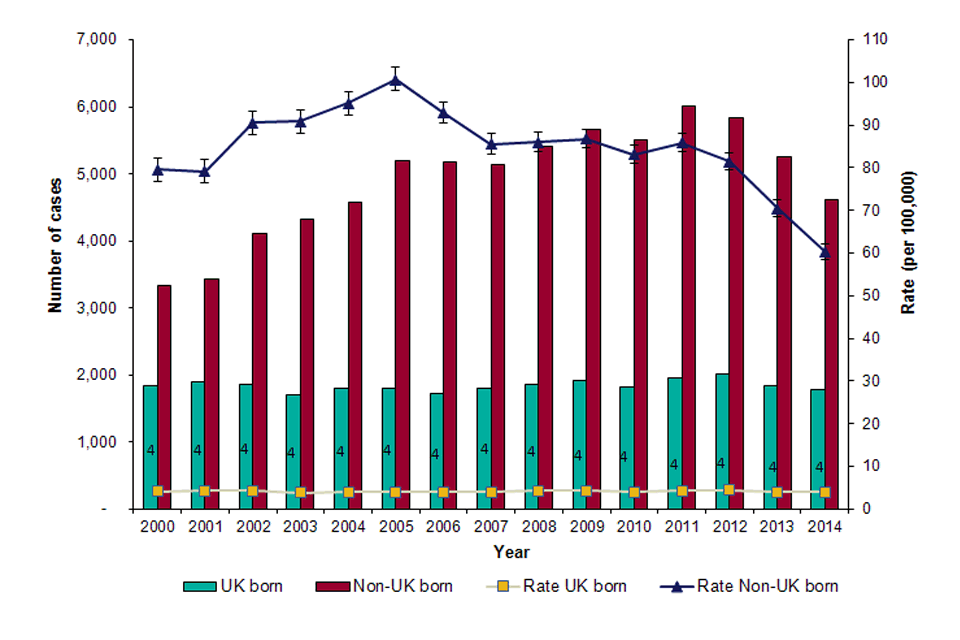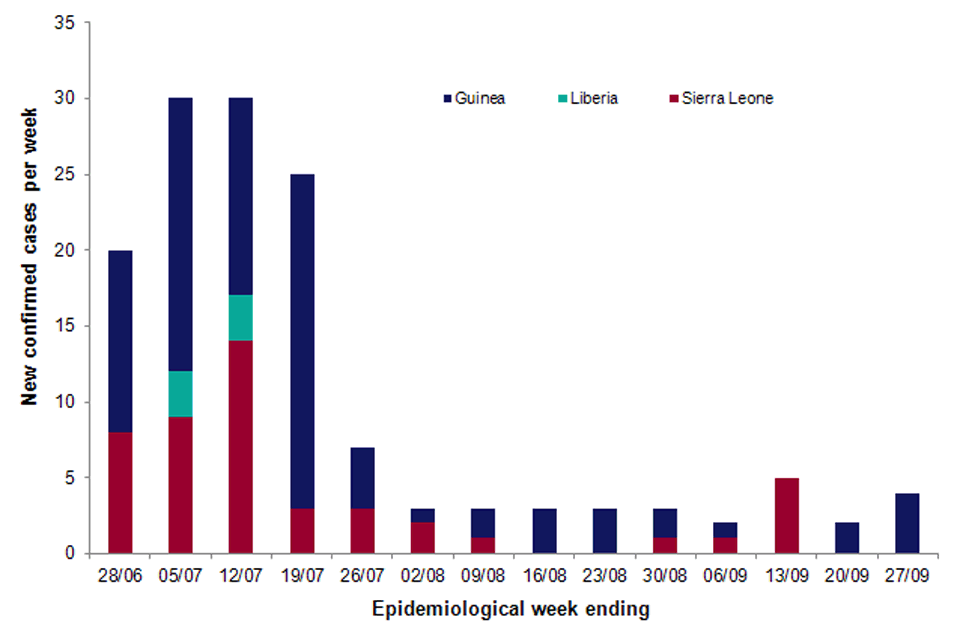HPR volume 9 issue 35: news (2 October)
Updated 29 December 2015
1. Annual report on tuberculosis in England
The Collaborative Tuberculosis Strategy for England, published in January 2015, outlined the improvements needed to achieve a sustained decline of TB in England [1]. PHE’s latest annual report, ‘Tuberculosis in England, 2015 report (presenting data to end of 2014)’, provides an overview of the epidemiology of the disease in England prior to implementation of the strategy [2].
In 2014, 6,520 cases were notified in England, a rate of 12.0 per 100,000, which was the lowest rate in England since 2000. The number of cases and the rate of TB in England have shown a year-on-year decrease over the past three years, with a 10% to 11% reduction in the rate annually from 2012. Despite this, the number of cases notified in England is still the highest in Western Europe [3].
The decline in the number of new cases, and in the incidence rate in the past three years in England is due to a reduction in the number of cases born outside the UK, which make up nearly three-quarters (71%) of TB cases in England (see figure below). In 2014, 4,610 of cases were born outside the UK, a rate of 60.3 per 100,000. There have been particularly large reductions in the numbers of cases born in India, Pakistan and Somalia, which accounts for 71% of the reduction in non-UK born cases since 2012.
The reduction in TB cases in the non-UK born population is likely to reflect recent declines in the number of migrants from high-TB burden countries and the impact of pre-entry TB screening. The majority of non-UK born cases (86%) are now notified more than two years after entering the UK, and are likely to be reactivation of latent TB infection. The roll out of latent TB testing and treatment, and further strengthening of TB services is required to ensure that the decline in non-UK born cases is sustained.
The rate and number of cases born in the UK have not shown a decrease over the past decade. In 2014, 1,774 cases were born in the UK, a rate of 3.9 per 100,000. This is three times higher than the rate in the native born population in the United States [4]. However, the rate of TB in UK born children aged less than 15 years, a proxy for TB transmission, has shown a steady decrease over the past three years, at 2.1 per 100,000 in 2014. This suggests a reduction of recent TB transmission in England.
Almost a third (30%) of pulmonary TB cases notified in 2013 experienced a delay from symptom onset to treatment start greater than four months, an increase in the proportion since 2011. In 2013, 41% of pulmonary TB cases aged 65 years and older experienced this delay, the highest proportion compared to other age groups.
Encouragingly, the proportion of drug sensitive cases expected to complete treatment within 12 months that have completed by this time has continued to increase, with 85% of cases notified in 2013 completing treatment by 12 months. The proportion of all drug sensitive cases that died at the last reported outcome has continued to decrease, with only 5% of cases notified in 2013 reported to have died.
1.1 Drug resistance
As in earlier years, approximately 6% of cases had initial resistance to isoniazid without MDR-TB, which occurred most frequently in cases with a previous history of TB or at least one social risk factor. In contrast, the number and proportion of initial MDR/RR-TB cases has decreased since 2011 (88 cases, 1.8%), with 56 MDR/RR-TB cases (1.4%) notified in 2014; the most frequent countries of birth of MDR/RR-TB cases were Lithuania (11 cases) and India (10 cases).
Only 56% of drug resistant cases notified in 2012 expected to complete treatment within 24 months completed treatment. The proportion of drug resistant cases known to have died at last reported outcome was similar to the drug sensitive cases at 4%.
1.2 Health inequalities, social risk factors and co-infections
TB remains concentrated in the most deprived communities; in 2014, the rate of TB was nearly seven times higher in those living in the most deprived areas (26 per 100,000) compared to those living in the least deprived areas (4 per 100,000). Almost one in 10 TB cases notified in 2014 had at least one social risk factor (past or current history of homelessness, drug or alcohol misuse or imprisonment), and the proportion of cases with a social risk factor was more than double in the UK born population (15%) compared with the non-UK born population (7%). Drug sensitive TB cases with at least one social risk factor were more likely to die or be lost to follow up than those without a social risk factor (5% versus 3%; 8% versus 3%, respectively) and treatment outcomes were also worse for MDR/RR-TB cases with at least one social risk factor.
Of cases notified in 2013, 3% of TB cases aged 15 years and above were co-infected with HIV, a continuation of the downward trend since the peak of 8% in 2004; 84% of TB-HIV co-infected cases were born outside the UK, with the majority born in Africa.
1.3 Next steps
In summary, the latest report on the epidemiology of TB in England before the implementation of the Collaborative TB Strategy for England 2015-2020 demonstrates encouraging trends in the overall rate of TB and the number of cases, and ongoing improvements in some indicators of service quality. However, it is important to be aware that reductions in the number of cases, and the rate, have been limited to the non-UK born population, particularly new migrants, and some indicators of service quality have not improved.
To achieve reductions in TB in England over the next five years, including in both new and settled migrants, in the UK born population and among the most vulnerable groups, will require us to build upon existing achievements and address gaps in current service provision. This will require the sustained and co-ordinated action of all key stakeholders, supported and overseen by the newly established TB control boards and national TB programme office.

TB case notifications and rates (95% confidence intervals) by place of birth, England, 2000-2014. Note: confidence intervals around the UK born population rate are small and therefore not visible.
1.4 References
- PHE (January 2015). Collaborative tuberculosis strategy for England 2015-2020.
- PHE (29 September 2015). Tuberculosis in England: 2015 report (presenting data to end of 2014).
- World Health Organization Global Tuberculosis Report 2014.
- CDC (October 2014). Reported tuberculosis in the United States 2013.
2. Ebola virus disease: international epidemiology summary (at 27 September 2015)
The West African Ebola Virus Disease (EVD) outbreak continues with a total of 28,424 clinically compatible cases (15,239 confirmed) reported as of 27 September 2015, 11,306 of which have died.
In the past two weeks, a total of six confirmed cases have been reported in West Africa, all in Guinea. All six cases are associated with a single chain of transmission which originated in the Ratoma area of the capital city, Conakry. Only one of these recent cases was diagnosed in Conakry, the other five were reported in the prefecture of Forécariah after a symptomatic individual travelled to this area for treatment before being diagnosed. Over 450 contacts remain under follow up in Guinea, all related to this chain of transmission.
It has been two weeks since the last case was reported in Sierra Leone. On 27 September, the country began a 42-day countdown to being declared EVD-free, as it discharged its last two known patients. A total of 795 contacts remain under follow up in Sierra Leone.
Liberia remains within a 90 day period of heightened vigilance following being declared EVD transmission free on 3 September 2015.

Number of new confirmed cases reported per week (28 June to 27 September 2015) in affected countries in West Africa. (Data source: WHO Ebola Situation Report 1 October 2015)
Further information on the epidemiological situation can be found in PHE’s weekly Ebola epidemiological update and from the Ebola outbreak distribution map.
3. PHE reminder on salmonella hazard associated with reptiles
PHE’s National Infection Service is investigating a number of cases of gastroenteritis caused by Salmonella Enteritidis PT8 – linked to exposure to reptiles, in particular snakes – and a reminder of the hazard intrinsic to the keeping of reptiles as pets has been published on the GOV.UK website [1]. As at 29 September 2015, 70 cases of S. Enteritidis PT8 had been identified across England since the start of the year.
The risk of salmonella infection for those handling reptiles is well established [2] and the raw or frozen mice used as snake feed are thought to be the principle route of disease transmission in the current outbreak. A reptile-associated outbreak involving a different salmonella strain was investigated in 2009 when such “feeder mice” were found to have been the source of infection [3].
Salmonella is found naturally in the gut of many animals, including reptiles. The bacterium can spread from the animals to cause infection in humans, in most cases causing only mild illness – diarrhoea, fever, abdominal pain or nausea. Children and babies can develop more serious illness. Estimates of reptile ownership in England vary between approximately one and five per cent of the population.
3.1 References
- “Reptiles pose a risk of salmonella infection”, PHE website news story, 29 September 2015.
- Reducing the risks of salmonella infection from reptiles, PHE factsheet.
- Ongoing investigation into reptile associated salmonella infections, HPR 3(14): news, 9 April 2009.
4. Eleventh World Rabies Day
The eleventh annual World Rabies Day was held on 28 September 2015 [1,2]. The aim is to raise awareness about the impact of human and animal rabies, and to highlight initiatives aimed at preventing and subsequently eliminating the disease. The World Health Organization estimates that rabies causes 55,000 – 70,000 deaths per year worldwide, many of these in children.
Rabies is an acute viral infection that is almost universally fatal, however prompt post-exposure prophylaxis (PEP) with rabies vaccine and human rabies immunoglobulin (HRIG) is highly effective at preventing disease. The infection is transmitted to humans mainly by bites, but exposure may also occur through scratches, contamination of broken skin or mucous membranes with saliva from an infected animal or bat.
The UK has been free of rabies in terrestrial animals since 1922, however UK bats may carry a rabies-like virus, European Bat Lyssavirus 2 (EBLV2).
Currently more than 1000 people in England and Wales, annually, are treated with PEP following possible rabies exposure, mainly travellers. Over half of putative rabies exposures to UK travellers occur in Asia and in particular India, Thailand and Turkey; the most common exposure resulting in PEP involves dogs, followed by bats, cats and monkeys. Since 2000 there have been five human deaths from rabies in UK citizens; four of these in travellers following exposure in rabies endemic countries, and the fifth in a bat handler infected in Scotland. None of these individuals had received post-exposure prophylaxis.
4.1 References
- WHO rabies factsheet (updated September 2015).
- “PHE in support of World Rabies Day”, PHE website news story.
